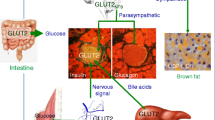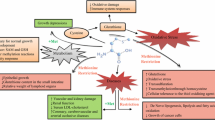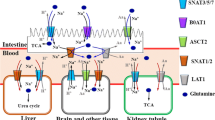Abstract
1) The effect of As2O3 and As2O5 on gluconeogenesis from various substrates in the liver and kidney of rats was investigated. 2) A concentration-dependent inhibition by As2O3 was found. The effect was not dependent on the amount of investigated material (hepatocytes or kidney tubules). For either hepatocytes or kidney tubules the extent of inhibition depended strongly on the substrate used. The highest degree of inhibition was observed in incubations with pyruvate. The inhibition of glucose formation was accompanied to a lesser extent by a diminution in O2 consumption and ATP content. The effect was also dependent on the substrate used. Maximum effect was found in incubations with pyruvate. 3) Oleate, 0.5 mmol/l, increased gluconeogenesis from pyruvate. The effect was not abolished by As2O3. 4) A decrease in the content of acetyl-CoA, 3-hydroxybutyrate, and reduced glutathione was found in suspensions of isolated rat kidney tubules or hepatocytes incubated with As2O3. 5) About 10 times higher concentrations of As2O5 were necessary to induce a similar extent of inhibition of gluconeogenesis, decrease in O2 consumption, and in ATP content as compared with As2O3. The extent of the As2O5 effect depended on the concentration of the toxicant and on the substrate used. Gluconeogenesis from pyruvate exhibited the highest sensitivity to As2O5. 6) All findings can be largely explained by inhibition of pyruvate dehydrogenase as the central target for arsenicals. The subsequent depletion of acetyl CoA results in impaired formation of reducing equivalents in the citric acid cycle, decrease in high energy phosphates and, acetyl CoA being a strong positive modulator of pyruvate carboxylase, in gluconeogenesis inhibition. Carbohydrate depletion, resulting mainly from gluconeogenesis inhibition, is proposed to be a major problem in poisoning with trivalent arsenicals. In accordance with this proposal, starved rats were shown to be much more sensitive to As2O3 than animals with free access to food.
Similar content being viewed by others
References
Armstrong CW, Stroube RB, Rubio T, Siudyla EA, Miller GB Jr (1984) Outbreak of fatal arsenic poisoning caused by contaminated drinking water. Arch Environ Health 39: 276–279
Barrit GJ, Zander GL, Utter MF (1976) The regulation of pyruvate carboxylase activity in gluconeogenic tissues. In: Hanson RW, Mehlman MA (eds) Gluconeogenesis. J Wiley & Sons, New York London Sidney Toronto, pp 3–46
Bencko V, Benes B, Cikrt M (1976) Biotransformation of As(III) to As(V) and arsenic tolerance. Arch Toxicol 36: 159–162
Bergmeyer HU (1974) Methoden der Enzymatischen Analyse. Verlag Chemie, Weinheim
Berry MN, Friend DS (1969) High-yield preparation of isolated rat liver parenchymal cells. J Cell Biol 43: 506–520
Berry LJ, Smythe DS (1959) Carbohydrate metabolism in normal and altitude-exposed mice following arsenite poisoning. Am J Physiol 197: 37–40
Brown H, Colmer JA (1929) The relation of arsenicals to the glutathione content of animal tissues. J Pharmacol 35: 417–424
Crawford TBB, Levvy GA (1947) Changes undergone by phenylarsenious acid and phenylarsonic acid in the animal body. Biochem J 41: 333–336
Davenport HW, Chavré VJ, Davenport VD (1956) Sulphhydryl groops and gastric acid secretion. Am J Physiol 184: 1–10
Franke KW, Moxon AL (1936) A comparision of the minimum fatal doses of selenium, tellurium, arsenic, and vanadium. J Pharmacol Exp Ther 58: 454–459
Ghafghazi T, Ridlington JW, Fowler BA (1980) The effects of acute and subacute sodium arsenite administration on carbohydrate metabolism. Toxicol Appl Pharmacol 55: 126–130
Ginsburg JM (1965) Renal mechanisms for excretion and transformation of arsenic in the dog. Am J Physiol 208: 832–840
Goorno WE, Rector FC Jr, Seldin PW (1967) Relation of renal gluconeogenesis to ammonia production in the dog and rat. Am J Physiol 213: 969–974
Guder WG, Wieland OH (1972) Metabolism of isolated kidney tubules; additive effects of parathyroid hormone and free fatty acids on renal gluconeogenesis. Eur J Biochem 31: 69–79
Guder W, Wiesner W, Stukowski B, Wieland O (1971) Metabolism of isolated kidney tubules; Oxygen consumption, gluconeogenesis, and the effect of cyclic nucleotides in tubules from starved rats. Hoppe Seyler's Z Physiol Chem 352: 1319–1328
Jocelyn PC (1975) Some properties of mitochondrial glutathione. Biochim Biophys Acta 369: 427–436
Krebs HA, Henseleit K (1932) Untersuchungen über die Harnstoffbildung im Tierkörper. Hoppe Seyler's Z Physiol Chem 210: 33–66
Mannervik B, Axelsson K (1978) The role of glutathione, thioltransferase, and glutathione reductase in the scission of sulphursulphur bonds. In: Sies H, Wendel A (eds) Functions of glutathione in liver and kidney. Springer-Verlag, Berlin Heidelberg New York, pp 148–153
Mize CD, Langdon RE (1962) Hepatic glutathione reductase. I. Purification and general kinetic properties. J Biol Chem 237: 1589–1595
Peters RA (1952) Lethal synthesis. Proc R Soc Ser B 139: 143–170
Peters RA (1955) Biochemistry of some toxic agents. I. Present state of knowledge of biochemical lesions induced by trivalent arsenical poisoning. Bull John Hopkins Hosp 97: 1–20
Pisciotto PT, Graziano JH (1980) Induction of mucosal glutathione synthesis by arsenic. Biochim Biophys Acta 628: 241–243
Rein KA, Borrebaek B, Bremer J (1979) Arsenite inhibits β-oxidation in isolated rat liver mitochondria. Biochim Biophys Acta 574: 487–494
Seglen PO (1972) Properties of rat liver cells. I. Effect of Ca2+ on enzymatic dispersion of isolated perfused liver. Exp Cell Res 74: 450–454
Szinicz L, Weger N, Schneiderhan W, Kiese M (1979) Nephrotoxicity of aminophenols: Effects of 4-dimethylaminophenol on isolated rat kidney tubules. Arch Toxicol 42: 63–73
Tateishi N, Higashi T (1978) Turnover of glutathione in rat liver. In: Sies H, Wendel A (eds) Functions of glutathione in liver and kidney. Springer-Verlag, Berlin Heidelberg New York, pp 3–7
Vahter M, Marafante E (1983) Intracellular interactions and metabolic fate of arsenite and arsenate in mice and rabbits. Chem Biol Interact 47: 29–44
Viña J, Hems R, Krebs HA (1978) Maintenance of glutathione content in isolated hepatocytes. Biochem J 170: 627–630
Webb JL (1966) Enzyme and metabolic inhibitors. Vol. III, Academic Press, New York London, pp 121–895
Williamson JR (1976) Role of anion transport in the regulation of metabolism. In: Hanson RW, Mehlman MA (eds) Gluconeo genesis. J Wiley & Sons, New York London Sidney Toronto, pp 165–220
Author information
Authors and Affiliations
Rights and permissions
About this article
Cite this article
Szinicz, L., Forth, W. Effect of As2O3 on gluconeogenesis. Arch Toxicol 61, 444–449 (1988). https://doi.org/10.1007/BF00293690
Received:
Accepted:
Issue Date:
DOI: https://doi.org/10.1007/BF00293690




